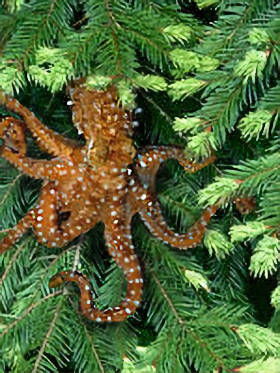Pacific Northwest tree octopus facts for kids
The Pacific Northwest tree octopus is a made-up creature. It was created in 1998 by a funny writer named Lyle Zapato. This writer made a special website about the tree octopus. Since then, the website has been used in many schools. Teachers use it to help students learn how to tell if information online is real or fake. It also shows how easy it is to believe things you read on the internet.
Contents
About This Made-Up Octopus
This pretend animal was given a scientific name: Octopus paxarbolis. The name means "Pacific tree octopus." It was said to be a type of cephalopod, like a regular octopus. But this one supposedly lived both on land and in water!
The story said it lived in the Olympic National Forest in the USA. It also lived in nearby rivers. It was said to lay its eggs in the water. The website even claimed its main enemy was the Sasquatch, another famous creature from folklore!
Learning About Online Hoaxes
The Pacific Northwest tree octopus website has been very helpful. It teaches kids about being careful with what they see online. It shows how important it is to check if information is true.
How Studies Were Done
Experts have done studies with students to see how they check online information. In one study, 13-year-old students were asked to look at the "Save The Northwest Pacific Tree Octopus" website. This website looked very real, with pictures and details.
The students were then asked to decide if the website was reliable. They had to give reasons for their answer. They also had to summarize the most important information. The goal was to see if they could spot that the website was a hoax.
Another study was done with 11 and 12-year-old students. They were also asked to visit the website. They answered questions about the octopus and if they would help save it. The researchers wanted to see if the students believed the story. They did not directly ask if the site was reliable. This was to avoid giving them a hint.
What the Studies Found
The studies showed that many students believed the tree octopus was real. In one study, more than half of the students thought the website was very reliable. Only a few students realized it was a hoax. The students who did spot the hoax had recently learned about being careful with online information.
In the other study, very few students realized the website was fake. The students often trusted the information. This was partly because they were in a school setting. They also trusted their teacher and the person running the study. Plus, the idea of helping an animal in danger made them want to believe it.
After the studies, the students learned the truth. Many were surprised they had believed the fake information. This showed them how important it is to think critically about what they read online. Even if a website looks real, it might not be true.
See also
 In Spanish: Pulpo arborícola del noroeste del Pacífico para niños
In Spanish: Pulpo arborícola del noroeste del Pacífico para niños


